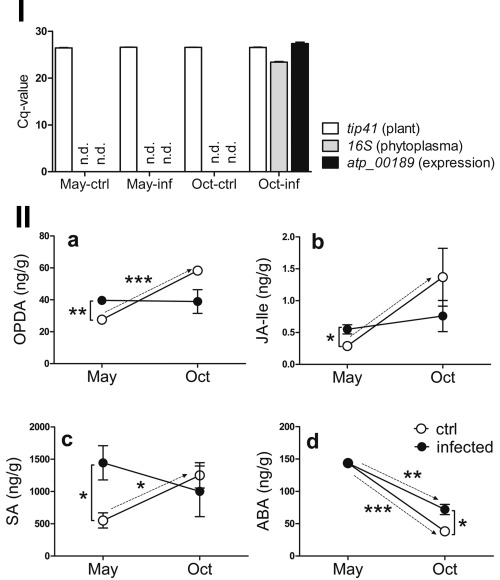Figure 3.

Levels of (+)−7‐iso‐jasmonoyl‐l‐isoleucine (JA‐Ile), cis‐12‐oxo‐phytodienoic acid (OPDA), salicylic acid (SA) and abscisic acid (ABA) in leaves of apple trees naturally infected with Phytoplasma mali. In infected apple trees, the presence of P. mali varies from May to October: In the top panel I, P. mali‐specific 16S and expression of atp_00189 were determined using quantitative polymerase chain reaction (PCR) with cDNA from leaves harvested in May and October (same pools as described below). As a control for equal cDNA amounts, plant‐specific tip41 was determined in parallel. Only in October could P. mali be detected and atp_00189 expression was confirmed when bacteria were present. Each pool was tested in technical triplicates. The mean Cq value of three independent pools for each condition is depicted + standard error of the mean (SEM). Results under the detection limit are designated as "not detected" (n.d.). OPDA, JA‐Ile and SA are elevated in leaves of P. mali‐infected trees in May when phytoplasma are not present in the canopy (top panel I and bottom panel II, a–c). The physiological increase in these hormones from May to October is inhibited in infected trees. Levels of ABA decrease from May to October in both control and infected trees (bottom panel II, d). In October, ABA is elevated in infected trees in comparison with the controls (bottom panel II, d). In panels I and II, for each time point, three pools of leaves from control or P. mali‐infected trees (6–11 trees/pool) were tested. The mean of three pools (n = 3) is shown ± SEM. Broken arrows in panel II indicate the trend of regulation from May to October for a simplified comparison between hormonal regulation in non‐infected vs. infected trees during these months. Differences between pools were determined with Student's t‐test. Significant differences are indicated by: *P < 0.05; **P < 0.01; ***P < 0.001.
